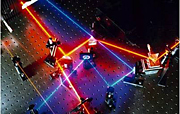- Number 311 |
- May 10, 2010
NREL finds a way to give LEDs the green light

NREL’s Solar Energy Research
Facility is the site of experi-
ments using lasers to probe
the light-emitting properties
of gallium indium phosphide
alloys for making light-emitting
diodes.
Light bulbs that last 100 years and fill rooms with brilliant ambiance may become a reality sooner rather than later, thanks to a discovery by DOE's National Renewable Energy Laboratory.
NREL scientists found a way to generate a tricky combination of green and red that may just prove to be the biggest boost for illumination since Edison’s light bulb.
Green isn’t just a symbol of environmentalism, it is a real color, and a desperately needed one for researchers looking for a way to light homes, streets and buildings at a fraction of today’s costs.
LEDs—light-emitting diodes—are the promise of the future because unlike tungsten bulbs or compact fluorescent bulbs, they deliver most of their energy as light, rather than heat.
To make an LED that appears white, researchers minimally need the colors red, green and blue. Red proved easy to generate, and about 15 years ago, Japanese scientists found a way to generate blue, thus providing two of the key colors from the spectrum of white light.
But green has been elusive. In fact, the $10 LEDs that people can buy now are made to look white by aiming the blue light at a phosphor, which then emits green. It works OK, but the clunky process saps a big chunk of the efficiency from the light.
Along came NREL, a world leader in designing solar cells, but a neophyte in the lighting realm.
NREL scientist Angelo Mascarenhas realized that an LED is just the reverse of a solar cell. One takes electricity and turns it into light; the other takes sunlight and turns it into electricity.
“We had already developed some of the know-how to capture sunlight in this green spectral region,” Mascarenhas said.
Why not try that same process, only in reverse, to make a reliable deep-green LED using gallium nitride and indium?
Astonishingly, once the concept was understood, Mascarenhas’s team produced a radiant deep green on their very first try. The aim now is to provide a fourth color to make that white light even whiter.
“We have full confidence that this is achievable,” Mascarenhas said.
[George Douglas, 303.275.4096,
george.douglas@nrel.gov]
